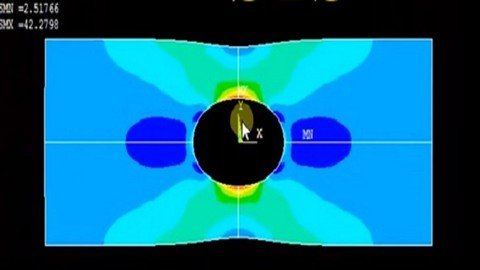Udemy - Mastering ANSYS with FEA & CFD (Computational Fluid Dynamics)
"softddl.org"
6-03-2022, 16:15
-
Share on social networks:
-
Download for free: Udemy -
-

MP4 | Video: h264, 1280x720 | Audio: AAC, 44.1 KHz
Language: English | Size: 3.00 GB | Duration: 5h 42m
Finite Element Analysis & Computational Fluid Dynamics Analysis using ANSYS

MP4 | Video: h264, 1280x720 | Audio: AAC, 44.1 KHz
Language: English | Size: 3.00 GB | Duration: 5h 42m
Finite Element Analysis & Computational Fluid Dynamics Analysis using ANSYS
What you'll learn
Express modeling and its role in the field of fluid flow and heat transfer
Apply the various discretization methods, solution procedures and turbulence modeling to solve flow and heat transfer problems
Interpret the knowledge, capability of analyzing and solving any concept or problem associated with heat energy dynamics and utilization.
Be able to generate 2-D and 3-D models for finite element analysis using ANSYS Mechanical APDL
Understand and conclude from the analysis results. The student will be able to assess any given structural engineering problem
Illustrate the working concepts of thermal engineering.
Be able to Solve Structural Engineering Problems using ANSYS MechanicalAPDL
Be able to Analyze and solve any Engineering Mechanics Problem using ANSYS Mechanical APDL
Requirements
Should have a grasp on Engineering Drawing, Solid Mechanics and a bit of Finite Element Analysis
Description
ANSYS Mechanical APDL for Finite Element Analysis provides a hands-on introduction to engineering analysis using one of the most powerful commercial general purposes finite element programs. APDL is the foundation for all sophisticated features, many of which are not exposed in the Workbench Mechanical user interface. Students will find a practical and integrated approach that combines finite element theory with best practices for developing, verifying, validating and interpreting the results of finite element models, while engineering professionals will appreciate the deep insight presented on the program's structure and behavior. Additional topics covered include an introduction to commands, input files, batch processing, and other advanced features in ANSYS.
Ansys Mechanical finite element analysis software is used to simulate computer models of structures, electronics, or machine components for analyzing strength, toughness, elasticity, temperature distribution, fluid flow, and other attributes. Ansys is used to determine how a product will function with different specifications, without building test products or conducting crash tests.
This course introduces new users, or experienced Ansys Mechanical users, to the Ansys Mechanical APDL user interface and also ANSYS Fluent . The Mechanical APDL workflow, graphical user interface, and analysis of simple mechanical components like Beam, Bar, Truss, Plate etc. With this foundation in place, users can apply this knowledge to efficiently set up, solve, and post process virtually any type of analysis. This course work is divided into two sections. First section contains Computational Fluid Dynamic analysis of Real-world Engineering problems using ANSYS Fluent. Second section contains multiple subsections, combining almost all types of Finite Element Analysis, e.g. Thermal Analysis, Structural Analysis, Analyzing Engineering Mechanics problems etc. using ANSYS Mechanical APDL. In this coursework nineteen videos are there containing practical applications of various types of Analysis.
Who this course is for
Engineering students who want to start their career as a Design Engineer or CAD/CAE/CFD professional can have enough confidence from this course.
Engineering Professionals who are already working in industry.
Any CAD/CAM/CAE Professional
Homepage
https://www.udemy.com/course/mastering-ansys-with-fea-cfd/Buy Premium From My Links To Get Resumable Support,Max Speed & Support Me

https://uploadgig.com/file/download/a22c42756F3D7e15/s9mpv.M.A.w.F..C.F.D.part1.rar
https://uploadgig.com/file/download/049864ddb79E9B33/s9mpv.M.A.w.F..C.F.D.part2.rar
https://uploadgig.com/file/download/27773aD80f3beF4b/s9mpv.M.A.w.F..C.F.D.part3.rar
https://uploadgig.com/file/download/B583C8825c4548ba/s9mpv.M.A.w.F..C.F.D.part4.rar

https://rapidgator.net/file/7f7af825037c36690714b20c951a046b/s9mpv.M.A.w.F..C.F.D.part1.rar.html
https://rapidgator.net/file/b6cb631ed72031f9041d5e5e9319d31e/s9mpv.M.A.w.F..C.F.D.part2.rar.html
https://rapidgator.net/file/38abe979d321382a583c2c1b235ffd39/s9mpv.M.A.w.F..C.F.D.part3.rar.html
https://rapidgator.net/file/44045dd04e275178b2fa073cc3c5f9c1/s9mpv.M.A.w.F..C.F.D.part4.rar.html

https://nitro.download/view/5FD9E6888B2C8EB/s9mpv.M.A.w.F..C.F.D.part1.rar
https://nitro.download/view/6E3F2CB1A08B002/s9mpv.M.A.w.F..C.F.D.part2.rar
https://nitro.download/view/37CD1FF96D6E597/s9mpv.M.A.w.F..C.F.D.part3.rar
https://nitro.download/view/BAE2D4B92ADA921/s9mpv.M.A.w.F..C.F.D.part4.rar
Links are Interchangeable - No Password - Single Extraction
The minimum comment length is 50 characters. comments are moderated




